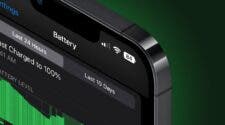When traveling – especially this summer- ensuring your iPhone doesn’t run out of battery is crucial, especially if you’re relying on it for directions and communication. While carrying a portable charger is one solution, optimizing your iPhone settings can also help extend battery life. Here are two key settings in iOS you should consider disabling to save battery life.

1. Remove Widgets from Your Lock Screen
Widgets on your lock screen might be convenient for quick updates, but they consume significant battery power. Widgets force apps to run in the background, constantly fetching data to update the displayed information. This continuous activity drains your battery, even when your phone is not in active use.
How Widgets Impact Battery Life
Widgets rely on background app refresh to update their content. This means the CPU and network resources are periodically activated to fetch new data, leading to increased battery consumption. The constant need for real-time updates can lead to quicker battery drain, especially if multiple widgets are in use.
How to Remove Widgets:
1. Switch Lock Screen Profile:
- Press and hold your current lock screen.
- Swipe to choose a lock screen profile without widgets.
2. Customize Existing Lock Screen:
- Press and hold the lock screen and tap Customize.
- Choose Lock Screen and tap on the widget box.
- Tap the “—” button on each widget to remove them.
By minimizing widgets on both the lock screen and home screen, you can significantly reduce background activity and save battery.

How I Improved My Battery Life
I used to rely heavily on widgets for quick updates on weather and sports scores. However, during a road trip, I noticed my iPhone’s battery would drain quickly. After some research, I decided to remove all the widgets from my lock screen. The difference was noticeable immediately. My battery lasted significantly longer, allowing me to use navigation apps and music streaming without worrying about finding a charger.
2. Turn Off Haptic Keyboard Feedback
Haptic feedback on the keyboard, introduced with iOS 16, adds vibrations to each keystroke, enhancing the typing experience. However, Apple has noted that this feature can affect battery life. Although the exact impact isn’t specified, turning off haptic feedback can help conserve battery power.
How Haptic Feedback Impacts Battery Life
Haptic feedback requires the Taptic Engine to activate each time you press a key. This mechanical movement consumes battery power. Over time, the cumulative effect of frequent typing with haptic feedback can lead to noticeable battery drain.
How to Disable Haptic Feedback:
1. Open Settings:
- Go to Settings on your iPhone.
2. Navigate to Sounds & Haptics:
- Tap on Sounds & Haptics.
3. Turn Off Keyboard Feedback:
- Select Keyboard Feedback.
- Toggle off Haptic.
Disabling haptic feedback will reduce the battery drain caused by the constant vibrations during typing.
Case Study: Saving Battery During Conference Trips
During a week-long conference, my colleague noticed that his iPhone’s battery was draining faster than usual. After some troubleshooting, he realized the new haptic feedback setting was on. By turning it off, he extended his phone’s battery life, which was crucial for staying connected and accessing conference materials without constantly searching for a charging outlet.
Additional Tips for improved iPhone battery life
Aside from disabling the two settings mentioned above, here are other tips to maximize your iPhone’s battery life:
- Enable Optimized Battery Charging: This feature reduces battery aging by learning your charging routine and waiting to finish charging past 80% until you need to use it.
- Monitor Battery Health: Regularly check your battery health percentage in the Battery Health menu. A battery health of 80% or higher is considered good. The menu also shows how many charge cycles your battery has gone through and whether it is performing normally.
- Limit Background App Refresh: Disable or limit background app refresh to prevent apps from consuming power when not in use.
- Reduce Screen Brightness: Lowering your screen brightness or enabling auto-brightness can help save battery life.
- Use Low Power Mode: When your battery is running low, enable Low Power Mode to reduce background activity and extend battery life.
- Disable Location Services: Turn off location services for apps that don’t need them. Go to Settings > Privacy > Location Services and select the apps you want to disable.
- Turn Off Push Email: Fetch email manually rather than automatically. Go to Settings > Mail > Accounts > Fetch New Data and set to Manual.
- Disable Siri Suggestions: Prevent Siri from making suggestions that activate apps in the background. Go to Settings > Siri & Search and turn off suggestions.
- Turn Off Background App Refresh: Completely disable background app refresh for all apps to save battery. Go to Settings > General > Background App Refresh and select Off.
Did it improve your iPhone battery life?
By making a few adjustments to your iPhone settings, you can significantly extend its battery life, ensuring it lasts throughout your travels. Removing lock screen widgets and disabling haptic keyboard feedback are two effective ways to reduce battery consumption. Additionally, following other battery-saving practices will help keep your iPhone powered up when you need it most.





